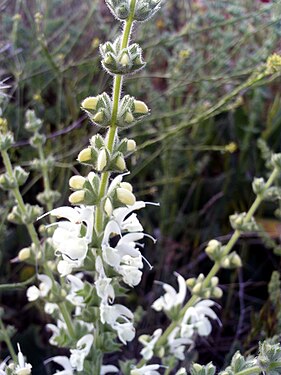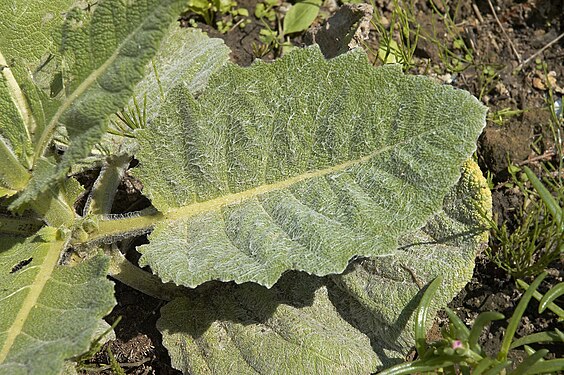Difference between revisions of "Salvia argentea"
| (3 intermediate revisions by 2 users not shown) | |||
| Line 1: | Line 1: | ||
| + | {{SPlantbox | ||
| + | |familia=Lamiaceae | ||
| + | |genus=Salvia | ||
| + | |species=argentea | ||
| + | |taxo_author=L. | ||
| + | |habit=herbaceous | ||
| + | |habit_ref=Flora - A Gardener's Encyclopedia | ||
| + | |Max ht box=24 | ||
| + | |Max ht metric=in | ||
| + | |height_ref=Flora - A Gardener's Encyclopedia | ||
| + | |Min wd box=24 | ||
| + | |Min wd metric=in | ||
| + | |Max wd box=40 | ||
| + | |Max wd metric=in | ||
| + | |width_ref=Flora - A Gardener's Encyclopedia | ||
| + | |lifespan=perennial | ||
| + | |life_ref=Flora - A Gardener's Encyclopedia | ||
| + | |exposure=sun | ||
| + | |sun_ref=Flora - A Gardener's Encyclopedia | ||
| + | |features=flowers, foliage | ||
| + | |flowers=white | ||
| + | |Temp Metric=°F | ||
| + | |min_zone=8 | ||
| + | |max_zone=11 | ||
| + | |image=Salvia argentea A.jpg | ||
| + | |image_width=180 | ||
| + | }} | ||
| + | '''''Salvia argentea''''' ('''Silver Sage''', '''Silver Salvia''' ), also known as '''Silver Clary''', is a biennial or short-lived [[perennial plant]]. It is native to northern [[Africa]]. In habit it is similar to the related European species ''[[Salvia sclarea]]'', forming a rosette of basal leaves in its first year, and flowering stems up to about 50 cm tall in its second year. Its leaves have a distinctive silvery white color (caused by numerous fine hairs), are about 8 inches long and rounded at the tip. <ref>Frances Tenenbaum. 2003</ref> | ||
| + | |||
{{Inc| | {{Inc| | ||
| − | Salvia argentea | + | Salvia argentea. (S. patula, Desf.). Biennial, 2-4 ft. high: sts. herbaceous, erect, villous: lvs. radical and lower cauline, 6-8 x 4-6 in., broad-ovate, sinuate- lobate, the lobes erose-crenate, lanate; floral lvs. very broad, acuminate, concave, persistent: panicles divaricate-branched; floral whorls remote, 6-10-fld., the uppermost abortive; calyx campanulate, striate, the teeth all subspinose; corolla showy, rose-white, whitish, purplish or yellowish, the galea or upper lip much longer than the lower. June. Medit. region of Eu. and Afr.— For some reason this species is considered a hardy perennial by American seedsmen. The foliage is white-woolly, making it a very decorative plant. |
}} | }} | ||
| − | + | ==Cultivation== | |
| − | + | ||
| − | + | ||
| − | + | ===Propagation=== | |
| − | + | ||
| − | + | ||
| − | + | ===Pests and diseases=== | |
| − | + | ||
| − | + | ||
| − | + | ==Varieties== | |
| − | + | ||
| − | + | ||
| − | + | ==Gallery== | |
| + | |||
| + | <gallery perrow=5> | ||
| + | File:Salvia argentea 14May2009 plant CampoCalatrava.jpg | ||
| + | File:Salvia argentea 14May2009 FlowersCloseup CampoCalatrava.jpg | ||
| + | File:Salvia argentea B.jpg | ||
| + | </gallery> | ||
| + | |||
| + | ==References== | ||
| + | <references/> | ||
| + | *[[Standard Cyclopedia of Horticulture]], by L. H. Bailey, MacMillan Co., 1963 | ||
| + | <!--- xxxxx *Flora: The Gardener's Bible, by Sean Hogan. Global Book Publishing, 2003. ISBN 0881925381 --> | ||
| + | <!--- xxxxx *American Horticultural Society: A-Z Encyclopedia of Garden Plants, by Christopher Brickell, Judith D. Zuk. 1996. ISBN 0789419432 --> | ||
| + | <!--- xxxxx *Sunset National Garden Book. Sunset Books, Inc., 1997. ISBN 0376038608 --> | ||
| − | + | ==External links== | |
| + | *{{wplink}} | ||
| − | + | {{stub}} | |
| − | {{ | + | __NOTOC__ |
Latest revision as of 07:36, 10 May 2010
| Habit | herbaceous
| |
|---|---|---|
| Height: | ⇕ | 24 in"in" can not be assigned to a declared number type with value 24. |
| Width: | ⇔ | 24 in"in" can not be assigned to a declared number type with value 24. to 40 in"in" can not be assigned to a declared number type with value 40. |
| Lifespan: | ⌛ | perennial |
| Exposure: | ☼ | sun |
|---|---|---|
| Features: | ✓ | flowers, foliage |
| USDA Zones: | 8 to 11 | |
| Flower features: | ❀ | white |
|
Salvia > |
argentea > |
L. > |
Salvia argentea (Silver Sage, Silver Salvia ), also known as Silver Clary, is a biennial or short-lived perennial plant. It is native to northern Africa. In habit it is similar to the related European species Salvia sclarea, forming a rosette of basal leaves in its first year, and flowering stems up to about 50 cm tall in its second year. Its leaves have a distinctive silvery white color (caused by numerous fine hairs), are about 8 inches long and rounded at the tip. [1]
Read about Salvia argentea in the Standard Cyclopedia of Horticulture
|
|---|
|
Salvia argentea. (S. patula, Desf.). Biennial, 2-4 ft. high: sts. herbaceous, erect, villous: lvs. radical and lower cauline, 6-8 x 4-6 in., broad-ovate, sinuate- lobate, the lobes erose-crenate, lanate; floral lvs. very broad, acuminate, concave, persistent: panicles divaricate-branched; floral whorls remote, 6-10-fld., the uppermost abortive; calyx campanulate, striate, the teeth all subspinose; corolla showy, rose-white, whitish, purplish or yellowish, the galea or upper lip much longer than the lower. June. Medit. region of Eu. and Afr.— For some reason this species is considered a hardy perennial by American seedsmen. The foliage is white-woolly, making it a very decorative plant.
|
Cultivation
Propagation
Pests and diseases
Varieties
Gallery
References
- ↑ Frances Tenenbaum. 2003
- Standard Cyclopedia of Horticulture, by L. H. Bailey, MacMillan Co., 1963
External links
- w:Salvia argentea. Some of the material on this page may be from Wikipedia, under the Creative Commons license.
- Salvia argentea QR Code (Size 50, 100, 200, 500)



